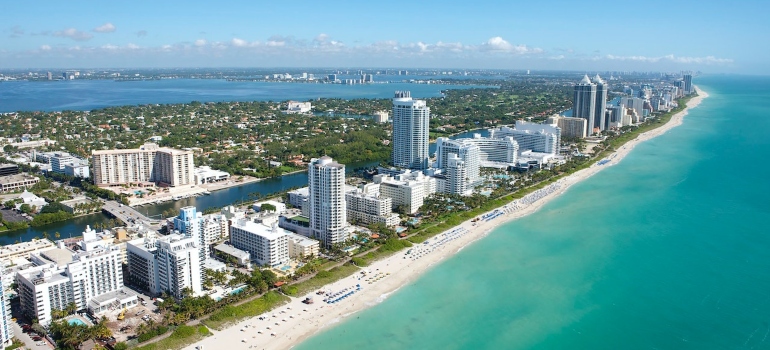Moving to Florida: A Complete Relocation Guide 2022
Ever longed to live in a state with hundreds of miles long beaches and one of the country’s most prominent art scenes? Well, that is the standard in Florida. Naturally, if you’re considering a relocation, you’ll want to gather some more data. The stuff we’re discussing extends well beyond the best beaches and best nightlife in the area. If you’re considering moving to Florida but aren’t sure if it’s the correct choice, keep reading. Best Cross Country Movers are always by your side with the most up-to-date information.
Things to know before moving to Florida
This guide will provide you with all the facts you need to know about Florida if you’re debating whether or not to make the move there. We’ll cover everything from your potential job search process, what educational facilities are good or not, the cost of living, taxes, which areas are the best, and so on. If by the end of your read, you do decide on moving to Florida, feel free to contact our reliable cross-country movers in Florida for help with the moving process.
Florida’s economy & job opportunities
The economy of Florida is praised as being among the biggest in the world. Although median incomes vary greatly from city to city, Florida ranks 17th in the nation for the lowest poverty rate at 14%. Moreover, several coastal communities are among the US’s richest.

As the headquarters of an increasing number of Fortune 500 businesses, Florida is a perennially fertile ground for finding work. In addition, several industries, including commerce, transportation, utilities, leisure, hospitality, government and professional services, education, healthcare, real estate, finance, insurance, and retail trade, provide many job prospects. Options abound. Florida is home to about 20,000 CEOs, yet the highest-paid professionals in the state are doctors and surgeons.
The unemployment rate in Florida is 3.5%, which makes it the 18th lowest in the US, while the state’s per capita personal income is about $48,000. For some further perspective, the median household income in Florida is $53,267. Keep in mind that Florida has a yearly inflation-adjusted minimum wage requirement. The state of Washington does not impose any kind of personal income tax, and we feel it’s important to stress that again. Many people are moving from California to Florida right now precisely for this reason.
Education opportunities in Florida
There are public schools, private schools, and even online schools in Florida. A lot of individuals take advantage of the city’s public schools because of the low tuition and wide availability. There are also many private schools in Florida, some of which may or may not be accredited. Plus, private high school grads are not forced to take any kind of accomplishment exams.
The State University System of Florida is made up of 12 different public institutions throughout the state of Florida. There are 28 state and community universities in Florida’s College System. Many private colleges and universities in Florida have banded together to form what is known as the Independent Colleges and Universities of Florida.

In addition, the government encourages and helps those who choose to educate their children at home. Florida’s public schools and universities are overseen by the FLDOE (Florida Department of Education). The homeschooling movement and private universities are outside of its purview. Florida’s official college dropout rate is 3.4%, as defined by the percentage of students who did not graduate after four years of study. Naturally, there are flaws in the technique, and a more precise estimate would be 13.1%. Whatever route you choose through higher education, you can do it in Florida. In this way, you may feel at ease about relocating to Florida for your kids’ or your own education.
Cost of living in Florida
Living in Florida is relatively cheap since its cost of living is lower than the U.S. average. However, this cost might increase by more than 17% from the national average if you want to relocate to a big city or metropolitan area.
When it comes to food, big cities like Miami and Tampa follow the trend by charging around 11% more than less populous sections of the state. As a result, the state as a whole has an average grocery price range that is 4% cheaper than the rest of the country. Due to the state’s warm temperature, it shouldn’t come as a surprise that Florida has above-average energy costs. The average monthly energy expense for a Florida resident is $126.44. That’s $13.03 more than the median cost of living in the United States of $111.67 a month. Healthcare expenditures in areas like Jacksonville are 16% below the national average. Also, they tend to be greater in sunny climates, like those of Vero Beach and Miami.
The housing market in Florida
The median price of a home in Florida is about $400,000. Of course, the city and the neighborhood might change their minds about this. Due to the state’s favorable investment climate and the state’s plentiful rental market, buying property in Florida is always a good decision.
Buying a house in Florida
Though owning a home in Florida has many advantages, you should be aware of the state’s astronomical property tax before making any final decisions. The average annual cost to a homeowner is $1,072, despite a real property tax rate of 0.98%, which is considerably lower than the national average of 1.08%.
Renting a house in Florida
Most individuals would rather rent than own, and in Florida, the monthly rent is often based on a fraction of the home’s market worth. Rent typically ranges from 0.8 percent to 1.1 percent of a home’s worth. On average, rent equals 1% of the price of a home, or $1,000 if the cost of the home is $100,000.

The median price of an apartment in Florida is $767 per month for an area of around 651 square feet. Once again, these are just general values. Costs may range from much cheaper to significantly more, depending on factors including the number of bedrooms, the kind of home, and the location.
Cost of utilities
The cost of utilities in Florida tends to be higher than average. When compared to the rest of the country, Florida vs Texas, for example, Floridians spend an average of $126.44 per month or 13% more than the Texas average of $111.67. Moving to Florida, you should know that monthly utility costs might go up to $100-$150. This, of course, varies by country. If you’re living alone in a studio apartment, your water bill may be as much as $90 a month. The price drops to $135 if you share a three-bedroom apartment with housemates. Remember that local variations in cost-of-living considerations should be factored in.
Tax rates in Florida
If you’re concerned that taxes will make a dent in your finances, stop thinking about it. If you’re worried about moving to Florida, you shouldn’t be. As if there weren’t enough good news, Florida has no personal income tax.
Yes, you read it correctly: Florida does not tax personal income! However, several counties in the state also impose their own sales tax, bringing the total sales tax to as much as 8.5%. This extra county tax ranges from 0.5 percent to 2.5 percent. It’s important to remember that local governments in Florida don’t tack on their own sales tax. As of right now, the average effective rate of property taxes in Florida is 0.98%, and they are solely collected at the county level.

In conclusion, if you fall into a higher income category, residing in Florida will save you a lot of money and effort. If you don’t, you’ll still be surprised by how low the state’s taxes are considering all the perks you’ll enjoy. We are seeing an influx of people moving from Minnesota to Florida, so you might want to follow in their footsteps as well.
How safe is Florida?
With a crime rate of 3.78 per 1,000 population, it is one of the safest states in the United States, with a victimization rate of 1 in 264. That’s below the national average here in the United States. The rate of property crime per 1,000 inhabitants is 21.46. According to the state’s yearly crime reports, residents and potential newcomers should rest easy. Naturally, it all comes down to the city and community that you call home. There will always be safer areas than others, it’s just a fact of life.
Getting around in Florida
The state of Florida is home to a plethora of different modes of transportation, including airports, ports, and commuter train services like Amtrak and Commuter Rail. More so, the Florida Shuttle Transportation Service provides bus service between several of the state’s main urban centers. Additionally, cities like Miami Beach and Punta Gorda have bike-sharing systems where you may borrow bicycles from the community.
Traffic issues, which may lengthen travel times, are a reality in large cities like Miami and Orlando. Florida drivers are rated fourth-worst in the US, according to a 2019 analysis by the financial website Smart Asset. In case you own a car, you should know that Florida has some of the highest gas taxes in the country. At 41.99 cents a gallon, Washington has the eighth-highest gas tax rate in the country. Conversely, the gas tax per gallon of fuel is 34.97 cents.
How to apply for Florida residency?
To qualify for residency in Florida, you must first live there for at least 183 days, which is the standard requirement for most states. Furthermore, the license application procedure must be completed within 30 days of establishing residence. In order to register or title a vehicle in the state, residents are required to get insurance from a company or agent authorized to do business in the state. Within 10 days of moving in, you must complete the registration/titling procedure.
Top 5 cities to live in Florida
Why is one location preferable to another? If you take a more introspective approach, you may find that some locations are more attractive than others due to factors like your personality type, the nature of your job, the presence of your social network, and so on. Nonetheless, you can’t even begin to think about any of that unless your current location meets certain criteria, including those related to safety, cost, and access to educational and occupational prospects. And those are the primary considerations that guided our selection of the top Florida cities to recommend to you.
1. Miami
Also, this city has every reason to rank at the top. Is boredom a possibility in Miami? So far, it has never occurred. Coconut Grove is a great place to go if you’re looking for a place to dine, shop, or have fun. Little Havana may be heaven on earth for someone who views cultural diversity as a source of enrichment. As well as, sure, the South Beach. Even if you only get to visit Miami once in your life, consider yourself lucky. Miami’s high real estate costs mean that most residents can only afford to share a home with other individuals or families. The average cost of purchasing a home in this bustling metropolis is over $364,000, while the average cost of renting a home is $1,679. If you want to move to Miami, interstate movers Miami will be more than happy to help you out.

2. Orlando
There are two major amusement parks here: one belonging to Walt Disney World and the other to Universal Studios. SeaWorld and Discovery Cove are two further options. For those who prefer more sedate entertainment, downtown is not to be missed. There is a plethora of fantastic art spaces, eateries, and shops. Houses in Orlando are seen as competitively priced compared to those in other popular housing markets. This is why it shouldn’t come as a surprise that the median home price in this area is $272,605. The average monthly cost of renting a home in this area is $1,391. Orlando has plenty of options so once you find your dream house, feel free to call interstate movers Orlando for a helping hand.
3. Naples
Naples, Florida, is a tiny city in Collier County with a total population of 21,564. It is also known as “the paradise of retired people” since so many retirees choose to make their permanent home there. It’s always ranked amongst the top US places for retirement. The roads in this charming community are always clear and safe. You may spend your day relaxing on the beach, shopping at one of many nearby malls, or taking a stroll through one of several nearby parks or boardwalks. When compared to the typical rent of $1,343, the median value of a property in Naples is $470,000, making homeownership a costly investment.

4. Sarasota
Sarasota brings to mind images of time spent with loved ones and relaxing on the beach. You may go kayaking and discover the natural beauty of Sarasota, or you can relax on the beach or at the theater. This location is nothing short of perfection on earth. A home in Sarasota may cost anywhere from $250,000 to $400,000 or more, with prices varying widely by neighborhood. It’s been reported that Sarasota has a 9% higher cost of living than the U.S. average. However, rents here average $1,446 per month. You can count on the best cross county movers in Sarasota if you’re planning on moving to Sarasota.
5. St. Augustine
Within its picturesque, historic 144-block historic neighborhood, St. Augustine has bustling art and cultural scene. St. Augustine is the finest area to live in Florida in 2022 due to the fact that it is ideal for both young families and older adults. It has become an even more vibrant crossroads of cultures and heritages in recent years, and Wallethub recently placed it fifth among the best beach towns in the United States. You don’t need more reasons to start preparing for moving to Florida right away.

